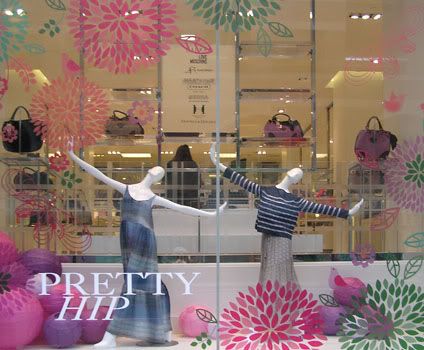 |
Currently at the Bay's King Street
window display
[Photo by KPA]
The Bay department store continues with its tradition of decorating its windows with a new theme for each season [1, 2]. Spring is for flowers, and the current window displays certainly showcase an explosion of flowers. But what happened to the fashion, since part of the display is to advertise what we might expect to buy for the season?
Hip[py] is in, pretty (despite the window's label) is out. It is "hip" to be a hippy, as in disheveled and un-pretty. (Notice how the lettering for "Hip" is slightly askew - leaning to the right, mimicking, approving of, those hip(py) mannequins.) I've written before that modern people have a visceral, negative reaction to beauty (prettiness is simply a variation - of a lower hierarchy - of beautiful). They hate it. I see it everyday in the clothes women wear in the streets: black; gray; formless coats; ugly boots. And in what the fashion magazines prescribe for us. I wrote in this post, Elimination of beauty:
Ugliness rules. In clothing, in films, in art and even in our "representatives" of beauty. I don't think it is a lack of knowledge about beauty. We've developed standards and often unanimous agreement about what constitutes the beautiful. So I'm not going to into the beauty-hater's argument that beauty is relative; beauty can be objectively measured. What's going on is that people are hating beauty. It is a form of envy. If I cannot be beautiful, then why is she beautiful? It is like wealth, or intelligence, or a sense of entitlement to live anywhere one pleases. Spread the wealth, accept I.Q.ers of 91 into Harvard, let everyone from every corner of the world come into the prosperous West. Or youth. Why cannot I be as young (and attractive) as any fifteen-year-old, at my ripe old age of seventy? Such are the mantra of the equal-opportunity narcissists.As I ponder more on what I've written above, I think the underlying premise is equality. We are all equal in our intelligence, our talents, our luck, our wealth, our youth (age), and of course our beauty. We are all beautiful. But, in order to make this equality a reality, we have to subscribe to the lowest common denominator. After all, it is much easier to lower the standards of beauty (how low can we get before we call it ugly?) than to reach for the higher echelons of beauty; it is much easier to make our young look old and haggard, to come to our level, since we can never look young and beautiful as only they can. This is the prescription to equality that we have been fed. But we don't have to accept it.
So, in order to fit in with their lowered standards, beauty magazines are (actually they have been, for decades now) publicizing ugliness in their fashion shoots, their models, and even with the "celebrities" and film actors they promote. There was a time when actresses like Elizabeth Taylor, Ingrid Bergman, Grace Kelly and many more appeared in immaculate clothing, looking ethereally beautiful, at any age. And we admired them.
Now, we get Lindsay Lohan, whose pretty features at twenty have deteriorated into the haggard face of a drunk and drug addict. The fashion literati are so mercilessly attacking this young woman that it cannot be anything else but malice - envy. Let's make this pretty girl into a monster. Unfortunately, Lohan, for lack of guidance and role models, obliges them with the images they can gloat over.
In the window display above, the bags (pouches) in the background are as unattractive as the clothes on the mannequins. I wonder what we are expected to put in these mini-luggages? It's odd, the less women require to put in their purses (according to current subscribed standards), i.e. lipstick, combs, mirrors, perfume, handkerchiefs, powder/cosmetic cases, the bigger the "hand" bags get.